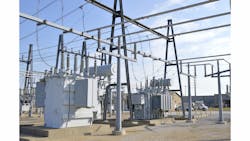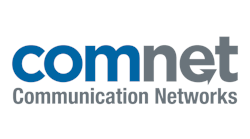How to Overcome Substation Transmission Challenges
For most of the history of the electric power transmission and distribution industry, electrical substations were thought of as assets with relatively minimal physical security concerns. The chain link fences surrounding them, and the well-known and ominous sounding signs that read “Danger – High Voltage, Keep Away” were usually sufficient to prevent unauthorized entry to or vandalism of these facilities, and more recently, the theft of valuable copper and other costly material.
Largely unreported within the media, a major Pacific Gas & Electric substation in Northern California supplying power to the Silicon Valley area was vandalized in April 2013, with a sniper damaging power transformer insulator bushings. Fortunately, the utility was able to reroute power at the facility, and the public experienced no outages.
In the world we now live in, substation security and surveillance have become major concerns on a global scale for electric power utilities and providers. The economic and life safety consequences of deliberate and maliciously incurred power outages are obvious.
NERC Compliance
The threat potential for these unattended and frequently remotely located and easily targeted facilities — which also include remotely located wind farm and photovoltaic array/solar power generation sites — is considered to be high, and of such critical national importance that the U.S. government has mandated that all power utilities in the U.S. and Canada must comply with the security requirements defined by NERC-CIP (North American Electric Reliability Corporation-Critical Infrastructure Protection) by April 1, 2017, or they will be subject to fines of $1,000,000 per day. As such, power utilities in these countries are under intense pressure to meet the difficult security regulations imposed by NERC-CIP.
NERC is a not-for-profit regulatory authority whose mission is to ensure the reliability of the electrical power system in North America, and it is subject to oversight by the Federal Energy Regulatory Commission (FERC) and governmental authorities in Canada. NERC's jurisdiction includes users, owners and operators of the bulk power system which serves more than 334 million people.
Although NERC-CIP is largely concerned with the threat of cyber-attacks to the entire national electrical power grid, physical security protection of this enormous critical asset is also required, in terms of video surveillance, access control and event recording — particularly at the point of power generation and at electrical transmission and distribution substations.
Substation Fiber Optic Transmission Challenges
The communication networks within the typical substation can be broken down into two key groups; the SCADA (Supervised Control and Data Acquisition) subsystem, used for interconnecting all of the substation IEDs (Intelligent Electrical Devices) and RTUs (Remote Terminal Units), such as metering, control and protective relaying equipment onto a common communications network; and the video and access control network, for supporting the physical security requirements at the site.
Substations are unique in that the environment where the electronic equipment is installed is extremely harsh — with severe voltage transients from high-voltage circuit breakers and other switchgear, and high levels of EMI (electromagnetic interference) emanating from large power transformers and other equipment. As the communications equipment for the SCADA and security sub-systems is usually located in an unconditioned shelter, or outdoors within weatherproof enclosures, it is also exposed to a very wide range of operating temperature and humidity with condensation conditions. In this severe environment, hardened fiber optic transmission equipment is widely used, largely due to its immunity to intense levels of electrical interference.
To maintain high levels of long-term reliability, the communications equipment for the video surveillance and access control subsystem must be capable of surviving in this kind of adverse operating environment with no performance degradation. Two key and universally employed industry standards define the environmental requirements for all substation-rated communications equipment fielded within an electrical substation: IEC 61850-3, and IEEE 1613.
Recognizing the growing demand for fiber optic transmission equipment capable of meeting these requirements, “substation-rated” products can be used for substation SCADA networks and for optically isolating electrically-delicate video cameras and other equipment from the harmful effects of EMI and voltage transients present within the substation. Managed, layer 2 Ethernet switches are used for creating VLANs for the SCADA network, the security and surveillance network, and any other communications requirements, such as VOIP, etc.
Unlike nearly all traditional industrial security applications, the operating power within the substation is of poor quality, with substantial electrical noise and voltage transients, and it is usually not the commonly available 120/240 VAC, but rather -48 VDC, or high-voltage AC/DC at 88-300 VDC or 85-264 VAC. The 88 to 300 VDC power is derived from large storage battery banks that provide back-up operating power for all of the equipment within the substation in the event of a localized power outage.
Specialized substation-rated thermal imaging IP CCTV cameras are now available not only for video surveillance purposes, but for remotely monitoring the operating temperature (and possible over-temperature condition) of large pad-mounted power transformers within the facility, for integration to the substation SCADA network. With the advent of modern IP video cameras and Ethernet-based access control equipment, it now becomes practical to easily integrate the physical security subsystem to the existing substation Ethernet SCADA network, with all of the equipment sharing a common, open standards-based Ethernet communications platform.
To overcome all of these challenges, ComNet recently introduced its Reliance line of substation-rated managed Ethernet switches, media converters and serial data modems that comply with IEC 61850-3 and IEEE 1613. They are designed to operate over any of the above input power ranges, and can also provide PoE power for IP video cameras and other remotely-located equipment. The use of substation-rated Ethernet transmission equipment provides the user with the potential for significant scalability for future system expansion, and a reliable, secure network terminating at the utility control center.
Bruce M. Berman is Vice President of New Business Development for ComNet. To request more info about the company, please visit www.securityinfowatch.com/10215705.



